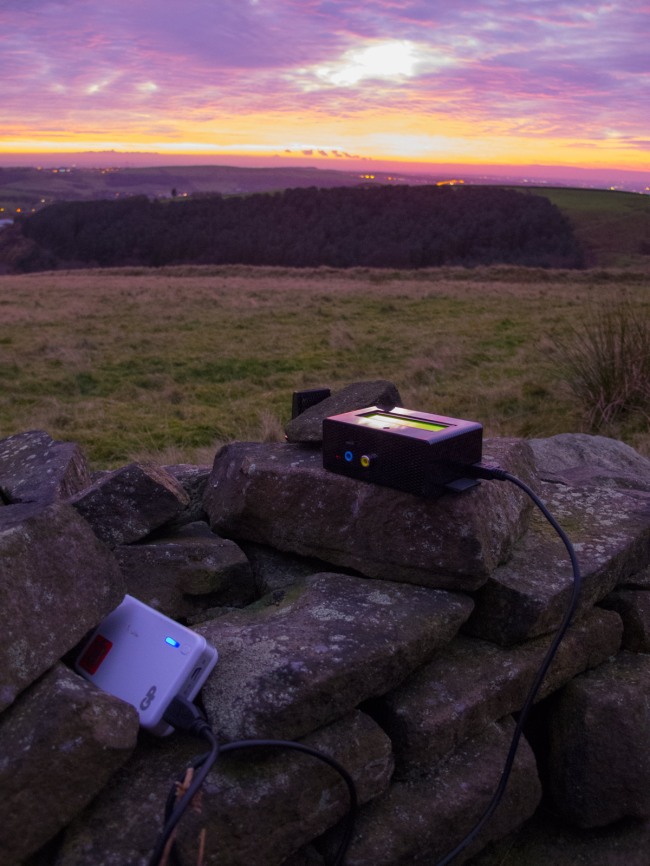Finding myself shivering in a field I wondered what else this credit card sized computer would be responsible for.
I was testing my new time-lapse setup with Raspberry Pi, a camera and PiFace Control and Display. When I do talks to teachers about why they should use a Raspberry Pi I point out you can put it in places you couldn’t put a PC, and I was certainly following my own words as I trekked up a hill overlooking Manchester. I’d previously tried pre-programming a Raspberry Pi that I could leave on a hillside to take pictures, but found I needed to change settings in the field. Taking a keyboard and monitor out with me was impractical, and sometimes it was hard to know if the Pi had started taking pictures.
Youtube compression isn’t great and doesn’t do justice to how reasonable the Raspberry Pi camera is.
Using PiFace Control and Display I could easily set the time between pictures and how long the time-lapse should cover. This is useful as often before I start taking a time-lapse I don’t know how much I want to speed the action up by, or how long to keep taking pictures for until I’m ready to start taking them. The display shows when the camera has started and how much room there is left on the SD card. It makes it really easy to take time-laspse with the Raspberry Pi. So much so I think I’m addicted!
The software is really easy to install – just type
sudo apt-get update
sudo apt-get install python3-snap-camera
There’s a quick video walking though setting it up from scratch and showing another time-lapse in the city centre.
It’s opensource and available on github, so hopefully between us and the community we’ll get more settings for the camera added. We’re also wondering about re-writing it to use Dave Jones’ python libraries for the Raspberry Pi Camera, or adding features like scheduling the time-lapse to start at a particular time.
For more info on things to do with PiFace visit our guides http://www.piface.org.uk/guides

Could you please tell us what all do i need to buy to replicate your setup for time laps photo.
You need a Raspberry Pi, a PiFace Control and Display, a Raspberry Pi Camera
http://uk.farnell.com/jsp/search/productdetail.jsp?sku=2334982&COM=embedded-link_RaspberryPiProjects
http://grh.premierfarnell.com/pageredir.aspx?c=EU1&u=jsp/search/displayproduct.jsp?SKU=2344458
http://uk.farnell.com/jsp/search/productdetail.jsp?sku=2302279&COM=embedded-link_RaspberryPiProjects
You can buy an enclosure for it here:
http://grh.premierfarnell.com/pageredir.aspx?c=EU1&u=jsp/search/displayproduct.jsp?SKU=2344458
and power it from a mobile phone battery charger
Hi I have been doing timelapse for a while now but so impressed with your article ordered up the Piface and box now fully working but 1 problem I cannot find the file to change so I can add -fh -fv
so my pictures are correct.way up in my setup Terry R
The snap camera program is installed on the Pi at /usr/bin/snap-camera
The code is also on github
https://github.com/piface/snap-camera/blob/master/snapcamera/camera.py
Look forward to seeing your time-lapse
Couple of my timelapses on Vimeo
Did not find the required file but now found camera.py will look at it closer tomorrow
might have a question on adding another command to flip the H & V of the camera
I wonder if I could ask if your option of pressing button 4 to exit could be put back in perhaps hold button for 5 second puts PI into a HALT state. If you are outdoors using battery once finished using the camera then you may crash the program even SD card if battery goes flat before getting home. Once in a HALT state battery can be removed for journey home.
That’s a good idea, hopefully it will get included in the next release
Hi Wonder if I could leave another suggestion as the camera is “in the field” then battery life is important. The timelapse mode one would say if 1 or mode hours was selected the LCD backlight could be turned off at the start of recording.
That is a good idea — we’ve updated our software so you can turn the backlight off by pressing one of the buttons, but really like your idea of turning it off based on time-lapse. Thanks
Hi I wonder if you would take another suggestion for the operation of snap-camera.
As the objective is to operate portable on a battery then the more power that can be saved the better. I have today carried out some measurement of current used on a Model A + Camera+PiFace. At rest waiting for a key press 180ma Video mode 420ma continuous Camera 320ma momentary timelapse 320ma continuous. So if you use timelapse for say 4 hours you end up using 50% more than taking single camer stills. This is due to the review being ON all the time. Perhaps if period is >5second then the camera should be NO review and turned On/OFF like the default for raspistill. This is no way any criticism of your program just trying to have a longest lasting portable system.